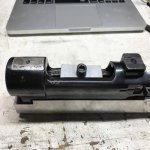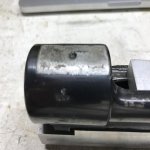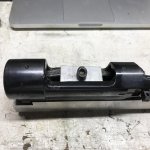- Location
- Western Manitoba
So, back in the day Parker Hale made and sold many types of commercial sporter mauser rifles - I have two here - one in marked Safari Super, the other is marked Safari De Luxe. Both of these have the soldered Parker Hale bases - no mounting screws, just a divot in the centre of each to accept the recoil stud on the Parker Hale rings. And, pretty much, ONLY Parker Hale rings fit these bases.
The Safari Super has been badly abused - the front base has been removed, although significant solder remains. I have a loose front base that was removed from a different rifle by someone else. I am considering trying to replace that front base, but am curious about what solder was used - one "story" is that it is genuine "silver solder" which was set while the receiver was going through it's heat treat series - requires very near to red hot temperature, apparently. The competing story is that it is basic lead/tin solder.
I have some 4% silver / 96% tin solder with appropriate flux that I intended to use - the melting point is about 450 F (220 C). Thought I would clean the surfaces, "tin" with the 4%/96%, then "sweat" the two pieces together.
So any comments appreciated - any hints how to clean off that old solder from the receiver and the base? Any "neat" ideas how to position and hold the thing in place as the "tinned" surfaces go liquid? Is this going to "wreck" this mauser receiver?
The Safari Super has been badly abused - the front base has been removed, although significant solder remains. I have a loose front base that was removed from a different rifle by someone else. I am considering trying to replace that front base, but am curious about what solder was used - one "story" is that it is genuine "silver solder" which was set while the receiver was going through it's heat treat series - requires very near to red hot temperature, apparently. The competing story is that it is basic lead/tin solder.
I have some 4% silver / 96% tin solder with appropriate flux that I intended to use - the melting point is about 450 F (220 C). Thought I would clean the surfaces, "tin" with the 4%/96%, then "sweat" the two pieces together.
So any comments appreciated - any hints how to clean off that old solder from the receiver and the base? Any "neat" ideas how to position and hold the thing in place as the "tinned" surfaces go liquid? Is this going to "wreck" this mauser receiver?
Last edited:













































































